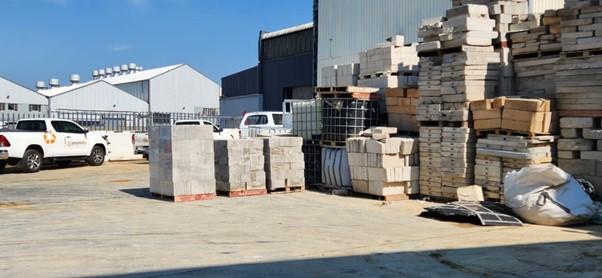South Africa is no stranger to heat waves, and in December 2024, many parts of the country endured record-breaking temperatures of 40 – 45°C. When the air is hotter than your internal body temperature (37°C) it becomes harder to keep cool, and the body gets warmer and warmer. This leads to heat stress, heat exhaustion, and finally, heatstroke, which can be deadly.
Knowing how to stay cool in hot weather is vital, especially considering that African summers are getting hotter every year. Historically, air-conditioning has been the cooling method of choice, but it’s not a sustainable option.
Despite its function indoors, air-conditioning makes the planet warmer overall. While the inside of the building stays nice and cool, the air-conditioning system pumps hot air outside. Plus, the machinery generates additional heat and consumes electricity in excess. But what alternative do we have? Is there a more sustainable way to keep cool, even during heatwaves?
Building Better Homes for Hot Weather
Most South African households cannot afford to cool their homes with air-conditioners. Running costs can range from R3.00 to R7.00 per hour, depending on the model and how you use it. Thankfully, there is a far more accessible option for all income levels: passive cooling. This concept is about keeping buildings cool without artificial climate control.
Insulation
Insulation creates an additional barrier between the outside and the inside of your home. It’s made from materials that don’t hold and transfer heat, many of which are recycled. Thermguard, for example, makes cellulose roof insulation from recycled labels and newsprint. Insulation creates air pockets that trap warm air and prevent it from getting into your house.
To make your roof and wall insulation even more effective, you can pair it with other insulating building materials. Silver roof paint helps reflect the sun’s rays to keep your home cool and Envirolite bricks (containing recycled polystyrene) reduce heat transfer through the walls.

Ventilation
Heat moving through the air is called convection. Understanding the principle that hot air rises and cool air sinks can help us design homes that stay cooler in summer. Window and door placement is crucial – having openings on either side of a room promotes airflow through the space, trapping cool air inside and pushing hot air out. This concept becomes even more important in multistorey buildings, where we can use the difference in air pressure to pull cool air into the building.
Shading
Most of the heat in your home comes through the windows. The glass gets hot in the sun and radiates warmth to other surfaces nearby. Shading your windows from the outside is the best way to prevent the sun’s rays from getting in. One can do this with awnings or with architecture that creates its own shade – deep patios, large roof overhangs, and irregular building façades. Trees and bushes can also provide shading.

Using Clean Energy to Keep Cool
The 26th of January is the International Day of Clean Energy. In South Africa, it couldn’t fall at a more relevant time of year. With midsummer heat soaring above 35°C at times, climate control becomes non-negotiable in the medical and food industries. However, it doesn’t have to come at the expense of the environment – alternative energy sources can make cooling far more eco-friendly.
Solar
South Africa saw a 349% increase in rooftop solar installations between March 2022 and June 2023. Still, only 10% of households use solar power and there is a huge opportunity for growth in the sector. Solar can power pretty much all cooling equipment, including air conditioners, fans, and fridges. Portable solar-powered fans and cooler boxes can make sustainable cooling and refrigeration more accessible in underserved communities.
Geothermal
Geothermal cooling is a sustainable way to maintain a constant air temperature within a building. Using a heat pump, warm air from inside is absorbed into a liquid – either refrigerant or clean groundwater – through a system of pipes. The pipes carry this liquid underground where heat is lost naturally. By the time the liquid circulates back into the building, it has been sufficiently cooled by the earth.
Biogas
Biogas is a mixture of predominantly methane and carbon dioxide. It’s a natural gas emitted by bacteria during the breakdown of organic waste. One can harvest biogas from landfill sites, farms, and sewage treatment plants and turn it into a source of clean energy for heating and cooling. Biogas is an affordable off-grid power source for rural areas.
Magnetic
Magnetic refrigeration uses 20 – 30% less electricity than traditional air-conditioners and fridges. When magnetic metals are exposed to a magnetic field, they heat up naturally. When removed from the field, they cool down. This is called the magnetocaloric effect. Powering cooling appliances this way eliminates the need for chemical refrigerants and compressors.
Using EPR To Make Sustainable Cooling a Reality
As global temperatures creep upwards, the need for sustainable cooling becomes even greater. In 2020, The International Energy Agency reported that switching to “climate-friendly cooling” could help us reduce greenhouse gas emissions by 460 billion tonnes. The sector holds abundant opportunities for investors and innovators, as highlighted by The World Economic Forum and The International Finance Corporation.
Yet true eco-friendly cooling technologies must also incorporate sustainable materials and ethical sourcing. Recycled plastics, waste-to-energy, and refurbished parts may prove useful in making cooling systems, either architectural or artificial, with a smaller carbon footprint. One way of accessing these resources is through extended producer responsibility (EPR).
Another interesting crossover between EPR and sustainable cooling is the reduction of e-waste. Electric cooling systems, such as air-conditioning, become e-waste when discarded. As such, importers and manufacturers must ensure responsible disposal.
In this way, the EPR system feeds the sustainable cooling industry and vice versa. Collaboration between engineers, recyclers, designers, and plastics and electronics producers can spark growth in sustainable cooling and build circular economies around secondary raw materials. For more information about EPR, or to get connected to our recycler and producer network, please contact us.


